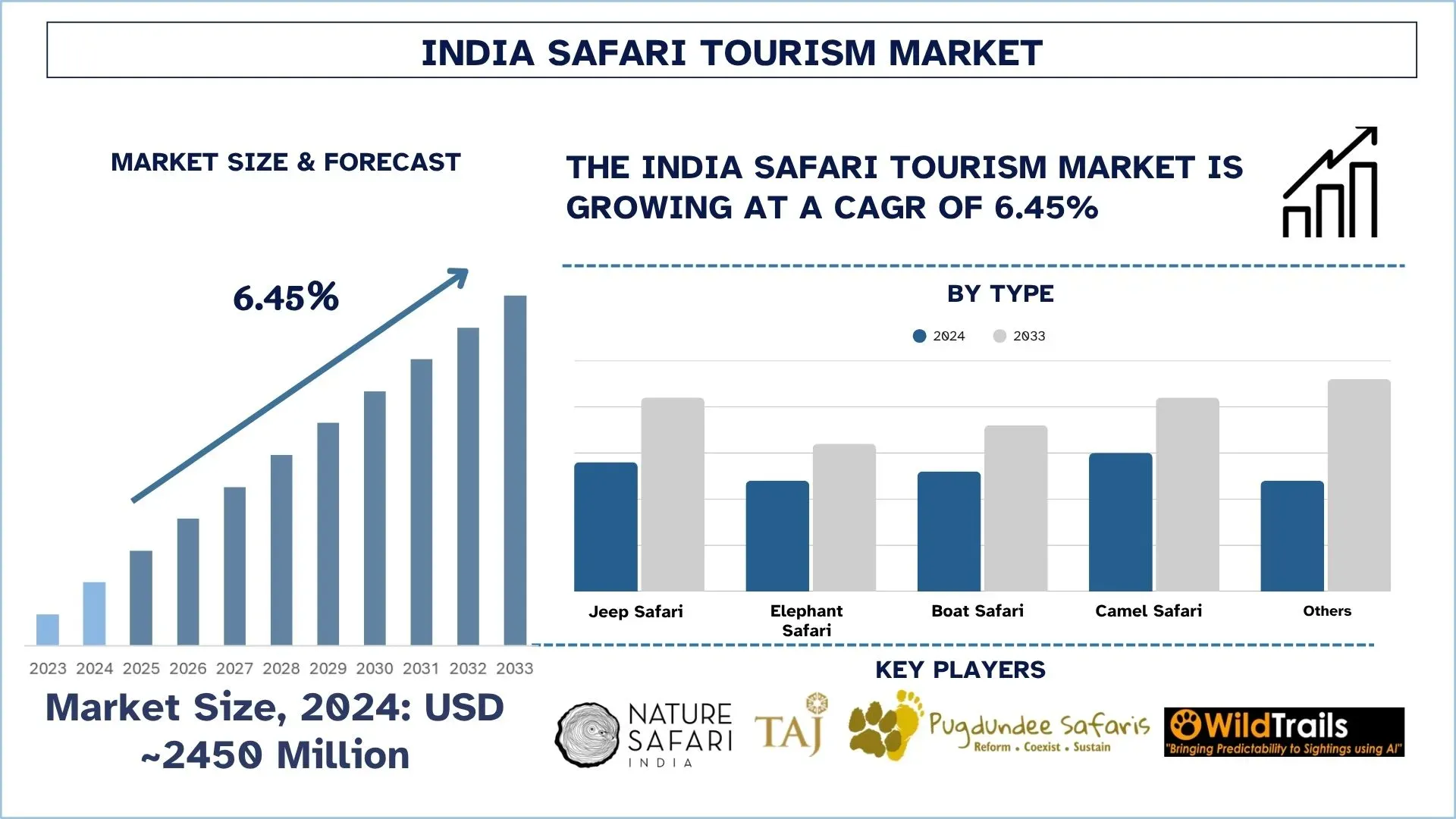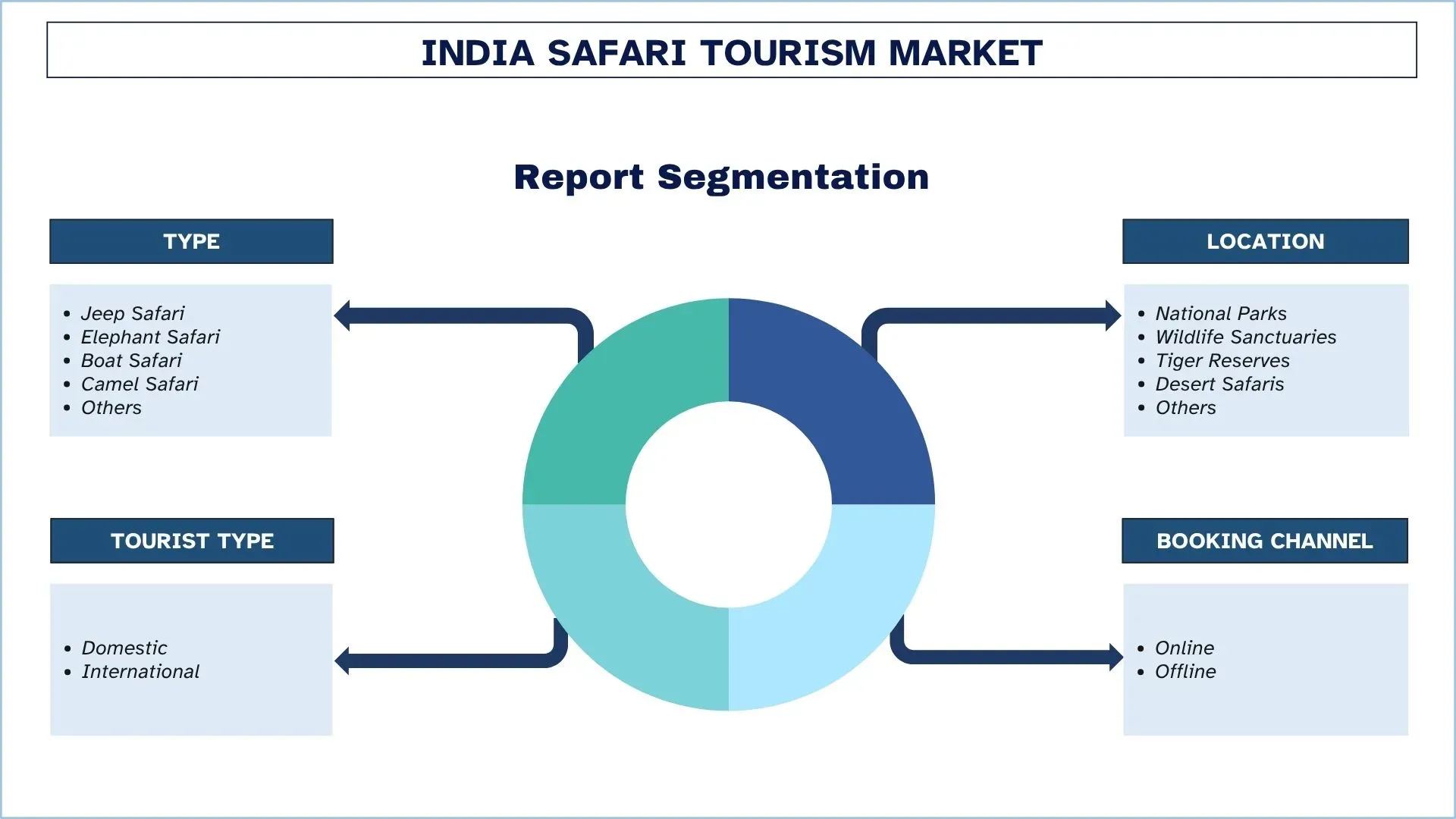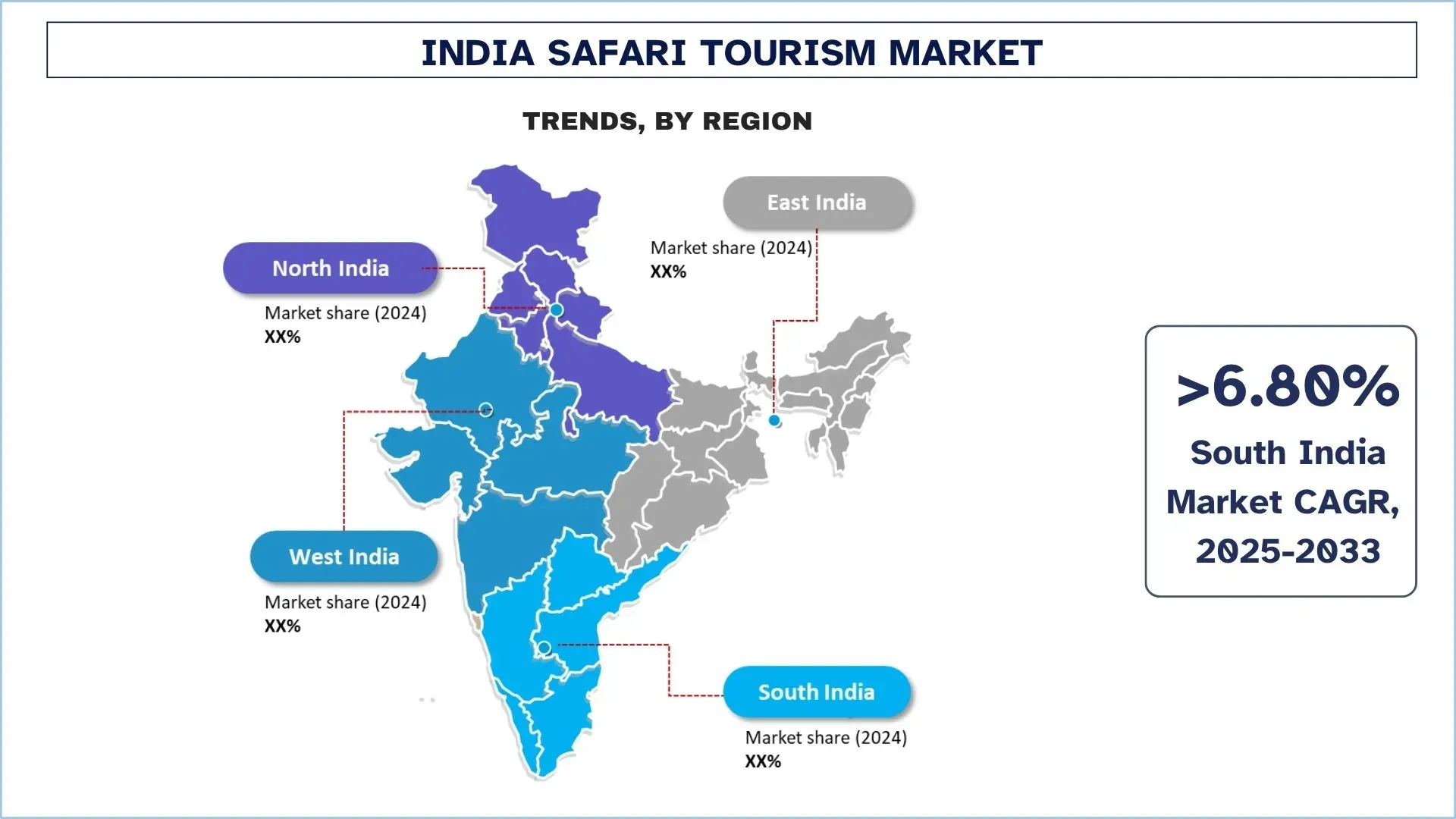- Home
- About Us
- Industry
- Services
- Reading
- Contact Us
India Safari Tourism Market: Current Analysis and Forecast (2025-2033)
Emphasis on Type (Jeep Safari, Elephant Safari, Boat Safari, Camel Safari, Others); Location (National Parks, Wildlife Sanctuaries, Tiger Reserves, Desert Safaris, Others); Tourist Type (Domestic, International); Booking Channel (Online, Offline); and Region/States

India Safari Tourism Market Size & Forecast
The India Safari Tourism Market was valued at USD ~2450 million in 2024 and is expected to grow to a strong CAGR of around 6.45% during the forecast period (2025-2033F), owing to the growing domestic tourism demand with more urban families seeking nature-centric holidays.
Safari Tourism Market Analysis
Safari tourism is a specialized sub-sector of tourism that entails organized campaigns to enter the wildlife reserves, national parks, and natural habitats to witness and experience the wildlife within their natural habitat. It entails guided safaris like jeep safaris, elephant safaris, boat rides, and foot trails where the tourists get an opportunity to see exotic flora and fauna, particularly flagship species of tigers, as well as elephants and rare birds. Safari tourism is a crucial sector in India in terms of animal conservation, economic activities of the locals, and it is also important for sustainable eco-tourism, which draws both local and foreign nature tourists willing to experience the untouched wild essence.
To attain growth in the safari tourism industry in India, safari operators and the government agencies are gradually incorporating eco-friendly operations, digital booking systems that are at an advanced level, and community-based tourism systems. Large corporations invest in luxurious eco-lodges with minimal environmental impact and encourage certification of the wildlife operators in good practice. Additionally, technology-based advancements like park entry through the phone, tracking vehicles, and the use of online permits make the tourist experience very convenient and increase park management. Besides, the establishment of partnerships in training guides and homestays, selling sustainable handicrafts to local inhabitants, also induces the spreading of economic gains at the grassroots level to encourage sustainable development and conservation achievement.
For instance, on June 11, 2025, the Assam Cabinet, led by Chief Minister Himanta Biswa Sarma, took a significant step to promote biodiversity conservation and enhance eco-tourism by approving the substantial expansion of Kaziranga National Park, adding an impressive 47,306.33 hectares to its area. The decision, announced officially on June 4, 2025, marks the park’s 6th extension and aims to reinforce the park’s status as a global conservation success story.
India Safari Tourism Market Trends
This section discusses the key market trends that are influencing the various segments of the India Safari Tourism market, as found by our team of research experts.
Integration of Wildlife Photography Workshops
This growing trend of wildlife photography workshops is becoming a major factor that is boosting the safari tourism industry in India. In these workshops, photographers, amateurs, and professionals alike come to be on the ground in some of the most wildlife-abundant areas with a qualified naturalist and award-winning photographer as their mentors. This increases not only the time spent by visitors but also improves the mode of payment through the high-end packages in the safaris. Besides, these specialized experiences also promote sustainable tourism since, most of the time, the people involved become wildlife conservationists just by spreading the photos and their tales to the rest of the world. With the increased demand for immersive learning holidays, safari operators are also increasingly incorporating photography workshops to offer customized offers to attract high-value tourist categories.
Safari Tourism Industry Segmentation
This section provides an analysis of the key trends in each segment of the India Safari Tourism market report, along with forecasts at the regional and state levels for 2025-2033.
The jeep safari market held the dominant share of the Safari Tourism Market in 2024.
Based on the type, the market is segmented into jeep safari, elephant safari, boat safari, camel safari, and others. Among these, the jeep safari market held the dominant share of the market in 2024, due to Jeep safaris being the most common pattern of wildlife excursion in India, because of their convenience and reach to articulate woodland domains and a greater probability of sighting iconic species such as tigers and leopards. This is a popular segment that forces tour operators to invest in a good 4x4 fleet and naturalists, which increases customer satisfaction. With the increased demand, firms are using jeep safaris to provide high-value packages to increase the occupancy rates and the per-trip earnings. For instance, on May 17, 2025, Uttar Pradesh launched India's first jungle safari via Vistadome train, connecting Katarniaghat Wildlife Sanctuary and Dudhwa Tiger Reserve. The train offers panoramic forest views through glass windows and roofs, aiming to boost tourism and the local economy.
The international segment is expected to grow with a significant CAGR during the forecast period (2025-2033).
Based on tourist type, the market is segmented into domestic and international. Among these, the international segment is expected to grow with a significant CAGR during the forecast period (2025-2033). The growth of international tourism is driven by the increased number of wildlife tourists inbound to the country to view the big cats in their natural environment and enjoy close encounters with the jungle. The ability of tour operators to meet the high expectations of service is through multi-lingual guides, luxurious accommodation, and pre-packaged tours. This flow of international tourists boosts the earnings of foreign exchange and attracts firms to promote India as a leading safari destination worldwide. According to the Ministry of Tourism, in December 2024, International Tourist Arrivals (ITAs) in India during 2023 were 18.89 Million. Foreign Exchange Earnings (FEEs) through tourism during 2023 were INR 231927 Crore (USD 27,951.45 million). Domestic Tourist Visits (DTVs) in India during 2023 were 2509 Million.

North India leads the Safari Tourism Market in 2024.
North India has proved to be a leading destination in safari tourism as it has iconic national reserves such as Jim Corbett, Ranthambore, and Dudhwa that annually draw thousands of wildlife seekers. It is easily accessible by both domestic and foreign tourists due to its good road and rail service links with Delhi and other important cities in the country. The operators take advantage of this to provide short, customizable safari tours, luxury accommodation, and upgrade heritage tours to the forts and palaces around. The variety of landscapes in the region, such as the dense forest and the grassland, coupled with high biodiversity, promotes high tourist satisfaction and continuous visits in the region. North India is strategically positioned and places iconic reserves that continue to grow aggressively in the market and maintain the profitability of safari tour operators.

Safari Tourism Industry Competitive Landscape
The India Safari Tourism market is competitive, with several global and international market players. The key players are adopting different growth strategies to enhance their market presence, such as partnerships, agreements, collaborations, new product launches, geographical expansions, and mergers and acquisitions.
Top India Safari Tourism Companies
Some of the major players in the market are Nature Safari India, Taj Safaris (The Indian Hotels Company Limited), Madhya Pradesh Tourism, Jungle Lodges & Resorts Ltd. (Karnataka Forest Department), Pugdundee Safaris, Rajasthan Tourism Development Corporation (RTDC), WildTrails, WILD WORLD INDIA, Travel Operators For Tigers India Wildlife Association (TOFTigers), and Indian Panorama.
Recent Developments in the India Safari Tourism Market
- On March 24, 2025, the Uttar Pradesh government is set to commence the construction of the ambitious 'Kukrail Night Safari and Adventure Park' in Lucknow next month. The project, which aims to boost tourism and wildlife conservation, will be developed in two phases with a total investment of over Rs 1,500 crore (USD 180.72 million).
On May 9, 2024, Indian Hotels Company (IHCL), India’s largest hospitality company, announced a strategic partnership with CG Hospitality, extending its current association of TAL Hotels & Resorts Limited and Taj Safaris Limited to achieve a portfolio of 25 hotels by 2025. Ekyam, the platform will primarily pursue opportunities in destinations that offer adventure experiences across the Indian Ocean and Greater Himalayan regions and wildlife escapes.
India Safari Tourism Market Report Coverage
Report Attribute | Details |
Base year | 2024 |
Forecast period | 2025-2033 |
Growth momentum | Accelerate at a CAGR of 6.45% |
Market size 2024 | USD ~2450 million |
Regional analysis | North India, South India, East India, and West India |
Major contributing region | South India is expected to grow at the highest CAGR during the forecasted period. |
Companies profiled | Nature Safari India, Taj Safaris (The Indian Hotels Company Limited), Madhya Pradesh Tourism, Jungle Lodges & Resorts Ltd. (Karnataka Forest Department), Pugdundee Safaris, Rajasthan Tourism Development Corporation (RTDC), WildTrails, WILD WORLD INDIA, Travel Operators For Tigers India Wildlife Association (TOFTigers), Indian Panorama |
Report Scope | Market Trends, Drivers, and Restraints; Revenue Estimation and Forecast; Segmentation Analysis; Demand and Supply Side Analysis; Competitive Landscape; Company Profiling |
Segments Covered | By Type, By Location, By Tourist Type, By Booking Channel, By Region/Country |
Reasons to Buy the India Safari Tourism Market Report:
- The study includes market sizing and forecasting analysis confirmed by authenticated key industry experts.
- The report briefly reviews overall industry performance at a glance.
- The report covers an in-depth analysis of prominent industry peers, primarily focusing on key business financials, type portfolios, expansion strategies, and recent developments.
- Detailed examination of drivers, restraints, key trends, and opportunities prevailing in the industry.
- The study comprehensively covers the market across different segments.
- Deep dive regional level analysis of the industry.
Customization Options:
The India Safari Tourism market can further be customized as per the requirements or any other market segment. Besides this, UnivDatos understands that you may have your own business needs; hence, feel free to contact us to get a report that completely suits your requirements.
Table of Content
Research Methodology for the India Safari Tourism Market Analysis (2023-2033)
We analyzed the historical market, estimated the current market, and forecasted the future market of the India Safari Tourism market to assess its application in major regions in India. We conducted exhaustive secondary research to gather historical market data and estimate the current market size. To validate these insights, we carefully reviewed numerous findings and assumptions. Additionally, we conducted in-depth primary interviews with industry experts across the Safari Tourism value chain. After validating market figures through these interviews, we used both top-down and bottom-up approaches to forecast the overall market size. We then employed market breakdown and data triangulation methods to estimate and analyze the market size of industry segments and sub-segments.
Market Engineering
We employed the data triangulation technique to finalize the overall market estimation and derive precise statistical numbers for each segment and sub-segment of the India-Safari Tourism market. We split the data into several segments and sub-segments by analyzing various parameters and trends, including type, location, tourist type, booking channel, and regions within the India Safari Tourism market.
The Main Objective of the India Safari Tourism Market Study
The study identifies current and future trends in the India Safari Tourism market, providing strategic insights for investors. It highlights regional market attractiveness, enabling industry participants to tap into untapped markets and gain a first-mover advantage. Other quantitative goals of the studies include:
Market Size Analysis: Assess the current market size and forecast the market size of the India Safari Tourism market and its segments in terms of value (USD).
Safari Tourism Market Segmentation: Segments in the study include areas of type, location, tourist type, booking channel, and regions.
Regulatory Framework & Value Chain Analysis: Examine the regulatory framework, value chain, customer behavior, and competitive landscape of the Safari Tourism industry.
Regional Analysis: Conduct a detailed regional analysis for key areas such as North India, South India, East India, and West India.
Company Profiles & Growth Strategies: Company profiles of the Safari Tourism market and the growth strategies adopted by the market players to sustain in the fast-growing market.
Frequently Asked Questions FAQs
Q1: What is the India Safari Tourism market’s current market size and growth potential?
The India Safari Tourism market was valued at USD ~2450 million in 2024 and is expected to grow at a CAGR of 6.45% during the forecast period (2025-2033). This steady growth is fueled by increasing disposable income, improved infrastructure, and a rising preference for wildlife and adventure experiences among domestic and international tourists.
Q2: Which segment has the largest share of the India Safari Tourism market by type?
The Jeep Safari segment accounts for the largest market share in India’s safari tourism sector. Its popularity stems from ease of access to rugged terrains, enhanced safety, and immersive wildlife viewing, making it the top choice for tourists exploring India’s national parks and wildlife reserves.
Q3: What are the driving factors for the growth of the India Safari Tourism market?
Major growth drivers include rising domestic and inbound tourism, government initiatives to promote wildlife conservation and eco-tourism, improved park facilities, digital booking platforms, and increasing awareness about sustainable and responsible travel practices among urban travellers.
Q4: What are the emerging technologies and trends in the India Safari Tourism market?
Key trends shaping this market include the adoption of eco-friendly safari vehicles, AI-powered wildlife tracking apps, virtual reality (VR) pre-tour experiences, luxury and customized safari packages, and community-based tourism models that involve local communities for authentic and sustainable experiences.
Q5: What are the key challenges in the India Safari Tourism market?
The sector faces challenges like habitat degradation, human-wildlife conflict, seasonal fluctuations in tourist footfall, limited digital penetration in remote areas, and the need for continuous training of guides and drivers to ensure safety and conservation standards are met.
Q6: Which region dominates the India Safari Tourism market?
North India is the dominant region, boasting renowned national parks like Ranthambore, Corbett, and Kaziranga (in the North-East). These parks attract both domestic and international wildlife enthusiasts due to their rich biodiversity, tiger sightings, and well-developed safari infrastructure.
Q7: Who are the key players in the India Safari Tourism market?
Some of the leading companies in the India Safari Tourism Industry include:
• Nature Safari India
• Taj Safaris (The Indian Hotels Company Limited)
• Madhya Pradesh Tourism
• Jungle Lodges & Resorts Ltd. (Karnataka Forest Department)
• Pugdundee Safaris
• Rajasthan Tourism Development Corporation (RTDC)
• WildTrails
• WILD WORLD INDIA
• Travel Operators For Tigers India Wildlife Association (TOFTigers)
• Indian Panorama
Q8: How can investors benefit from India’s growing Safari Tourism market?
Investors can tap into this booming market by investing in eco-lodges, safari camps, customized luxury tour operations, and technology platforms for online bookings and virtual safaris, aligning with India’s sustainable tourism goals and rising wildlife travel demand.
Q9: How is the Indian government supporting the Safari Tourism sector?
The government promotes safari tourism through policies encouraging eco-tourism, funding for wildlife conservation, upgrading park infrastructure, community development programs around protected areas, and campaigns showcasing India’s unique biodiversity to attract global tourists.
Related Reports
Customers who bought this item also bought










